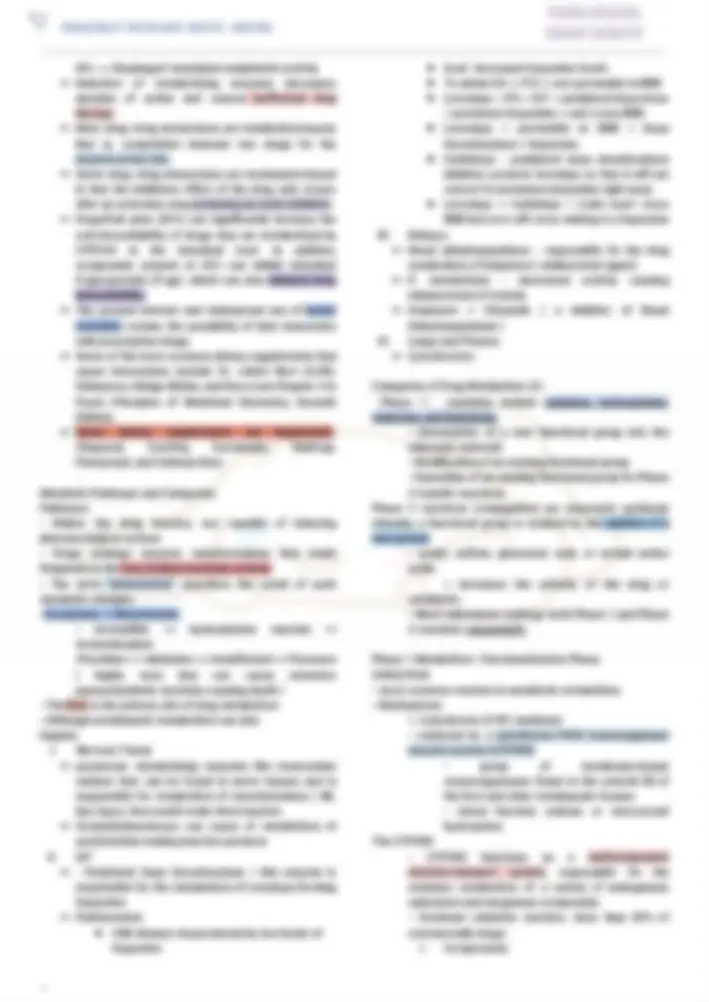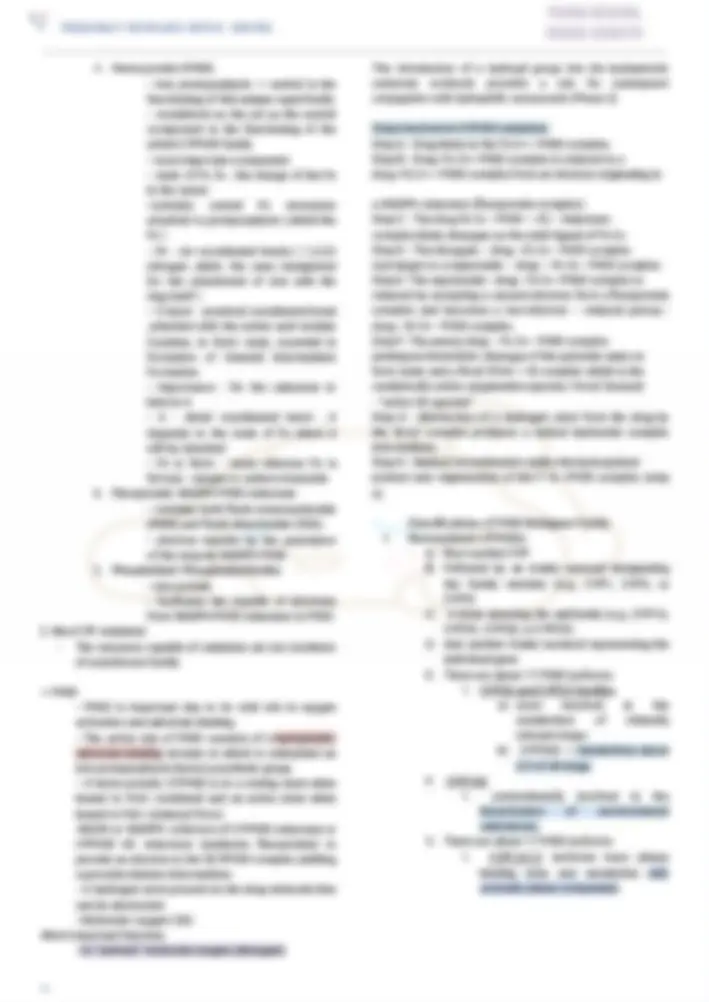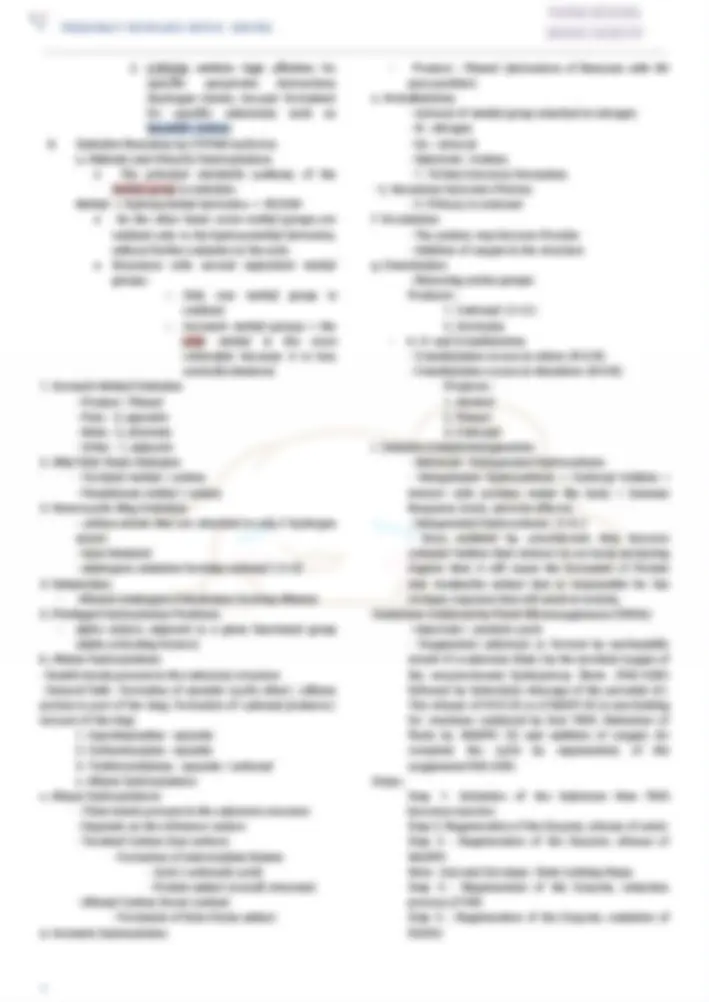Download Importance of Drug Metabolism and more Lecture notes Pharmaceutical Chemistry in PDF only on Docsity!
Module 5 : DRUG METABOLISM
- Drugs are important substances responsible for pharmacological actions
- Drugs effect should not be perpetual (long term) otherwise drug could produce toxic effects
- Drugs are important to be excreted
- Drug should undergo a process of metabolism
Introduction & Importance : Introduction
- Xenobiotics require to undergo biotransformation for them to be excreted as hydrophilic metabolites. - Enzymes – hepatic and extrahepatic
- Hydrophilic metabolites
- drugs are already ionized, and said to be polar, this only happens if drugs underwent metabolism Metabolism
- also known as Biotransformation
- Could only happen because of biological catalysts called enzymes Importance of Studying Drug Metabolism ● Understanding biotransformation and bioactivation of xenobiotics is essential in assessing drug safety ● Pharmacologic and toxicologic activities of a drug are consequences of its metabolism ○ In order for us to know if the drug is safe or toxic ○ Pharmacologic - inactive, active (prodrug) ready for secretion ○ - Toxicological - APAP - hepatotoxicity ● Studying drug metabolism can often aid the prediction of the consequences of: ○ drug– drug interactions (page 49-50), ○ drug–food interactions (page 49-50), ○ herbal drug–drug interactions, and ○ help to explain patients’ adverse responses to drug regimens ● NOTE: ○ Are all xenobiotics susceptible to metabolism?
- Hydrophilic Drugs -> Paracellular transport
Paracellular transport:
- drugs will enter the cell through the presence of cellular pores
- Pores are seen beside each cell or cell membrane
- Hydrophilic - do not need metabolism - shortcut
- Resistant to metabolizing enzymes
- Excreted largely “unchanged”
Factors Affecting Drug Metabolism
- drug metabolism is not absolute
- Not same faith of drugs in each individual, different factors that could affect drug metabolism resulting to certain variations
- Genetic Factors ● depends on racial and ethnic characteristics
● Pharmacogenomics: the study of heritable traits affecting patient response to drug treatment ● dictate certain characteristics and also synthesis of enzymes ● Because of genetic factor human enzymes produced ● may vary resulting in variation of activities ● Very important factor Case : metabolism of ethanol
- If entered the body there is a metabolic faith
- As an organic compound the faith of alcohol is oxidation thus it is a primary alcohol
Ethanol >> alcohol dehydrogenase >> Acetaldehyde (intermediate product, toxic in the body when accumulated causing nausea and vomiting, tachycardia, redness) >> aldehyde dehydrogenase >> Acetic acid (non toxic, readily excreted)
Take away :
- Acetic Acid
- ultimate product of ethanol metabolism
- happens because of alcohol dehydrogenase and aldehyde dehydrogenase
- Aldehyde Dehydrogenase
- Genetics : expression is not the same in all races
- Some races AD is poorly expressed > low AD > accumulation of acetaldehyde resulting to redness > high alcohol intolerance
- Physiologic Factors
- depends on someones physiology on what her/him body would be the response to the drug
- Age ● Age is a factor since the very young and the very old have impaired metabolism ● In the elderly, there is a decline in drug metabolism related to decreases in hepatic blood flow, glomerular filtration rate, hepatic microsomal enzyme activity, plasma protein binding, and body mass resulting in profound changes in drug plasma concentrations and renal clearance. ● There are a number of important metabolizing enzymes in the placenta helping to protect the fetus. However, the fetus and newborns are deficient in some microsomal enzymes, particularly glucuronide conjugation, which can lead to jaundice in newborns.
- Pregnancy ● Different approach / response to drug metabolism because of their sensitivity
- Hormones ● Male and Female hormones varies
- Gender
● Gender differences in metabolism between men and women, although not clearly understood, might be associated with hormonal differences which can lead to different levels of inducible oxidizing enzymes (CYP3A4). ● Side-chain oxidation of propranolol is 50% faster in males than in females. ● Drugs that are cleared by oxidative metabolism are more rapid in males than in females (i.e., chlordiazepoxide and lidocaine). ● Diazepam, prednisolone, caffeine, and acetaminophen are metabolized slightly faster by women than by men.
- Changes in intestinal flora ● They have metabolizing enzymes / metabolic activity
- Disease ● Disease states that cause enhanced activity of enzymes / reduced activity
- Nutritional status
- Pharmacodynamic and Pharmacokinetic factors ● Dose, frequency, and route of administration, plus tissue distribution and protein binding of a drug, affect its metabolism. ○ Example: Conjugation of drugs with glutathione ● Since there is a limited amount of glutathione available for conjugation, the dose and frequency of dosing of drugs conjugated by glutathione can saturate the system and lead to alternative paths of metabolism. ● Tissue distribution ● Protein Binding ● Higher dose -> greater the extent of metabolism ● Frequency -> the more frequent the greater frequency of metabolism ● Route of Administration - less requirement for metabolism / more requirement for metabolism
- Environmental Factors ● Interaction with environmental substances ● Ingested or inhaled environmental substances can compete for metabolizing enzymes, induce or inhibit enzymes, or even poison enzymes (carbon monoxide and pesticides).
- Drug-drug, drug-food, and DrugSupplement Interactions ● Alteration of drug metabolism ( we can change , modify the potential activity of drugs ) ● Enzyme Induction ○ enhanced rate and extent of metabolism ○ happens if there is a cause ○ suspects “ enzyme inducers “
Metabolism Inducers Examples
Tuberculosis Drugs Rifampin, Isoniazid
Anti- Seizure Drugs Phenobarbital, Phenytoin
Environmental Toxins Polycyclic aromatic hydrocarbons
Additional Drugs Prednisone Ethanol
● Enzyme Inhibition ○ reduced rate and extent of metabolism ○ suspects “ enzyme inhibitors “ Metabolism Inhibitors Example
Macrolide antibiotics Erythromycin
Imidazole antifungals Ketoconazole
Quinolone antimicrobial Ciprofloxacin
Additional Drugs Cimetidine, Omeprazole, Ranitidine
● Drug - Drug Interactions ● Two characters involved ● Suspect (cause, precipitant drugs) / Victim (affected, object drug) Object : Warfarin Rifampin
- Inducer
- Stimulates the enzyme that would metabolize warfarin
- It would inactivate, degrade, destroy warfarin
- Enhanced metabolism of Warfarin
- High inactive form
Less effect
Taken all together : Warfarin is a drug that causes bleeding however if it is paired with Rifampin, it will reduce the effect causing clot / thrombosis
Cimetidine
- Inhibitor
- Reduced enzymatic action
- Reduced inactivating, reduced metabolism
- Extended action enhancing its effect
- Resulting to extensive bleeding
Examples of GFJ–Drug Interactions GFJ → Statins rhabdomyolysis GFJ → Dihydropyridines increased vasodilation GFJ → Repaglinide hypoglycemia GFJ → Amiodarone increased toxicity
A. Heme protein (P450)
- iron protoporphyrin -> central to the functioning of this unique superfamily
- considered as the set as the central component in the functioning of the whole CYP450 family
- most important component
- state of Fe 3+ , the charge of the Fe in the center •contains central Fe structures attached to protoporphyrin ( shield the Fe )
- Fe - six coordinated bonds ( 1,2,3, nitrogen sided. the ones designated for the attachment of iron with the ring itself )
- 5 bond - proximal coordinated bond ,attached with the amino acid residue Cysteine, in ferric state, essential in formation of Oxenoid Intermediate Formation
- Importance : for the substrate to bind to it
- 6 - distal coordinated bond , it depends to the state of Fe where it will be attached
- Fe is ferric - water whereas Fe is ferrous - oxygen or carbon monoxide B. Flavoprotein: NADPH-P450 reductase
- contains both flavin mononucleotide (FMN) and flavin dinucleotide (FAD).
- electron transfer by the assistance of the enzyme NADPH-P C. Phospholipid: Phosphatidylcholine
- non-protein
- facilitates the transfer of electrons from NADPH-P450 reductase to P
- Non-CYP mediated
- The enzymes capable of oxidation are not members of cytochrome family
-> P
- P450 is important due to its vital role in oxygen activation and substrate binding.
- The active site of P450 consists of a hydrophobic substrate-binding domain in which is embedded an iron protoporphyrin (heme) prosthetic group
- A heme protein: CYP450 is in a resting state when bound to Fe3+ (oxidized) and an active state when bound to Fe2+ (reduced form). •NADH or NADPH: cofactors of CYP450 reductase or CYP450 b5 reductase (nonheme flavoprotein) to provide an electron to the SCYP450 complex yielding a peroxide dianion intermediate.
- A hydrogen atom present on the drug molecule that can be abstracted.
- Molecular oxygen (O2) •Most important function:
- to “activate” molecular oxygen (dioxygen)
The introduction of a hydroxyl group into the hydrophobic substrate molecule provides a site for subsequent conjugation with hydrophilic compounds (Phase 2)
Steps involved in CYP450 oxidation: Step A : Drug binds to the Fe 3+ > P450 complex. Step B : Drug–Fe 3+> P450 complex is reduced to a drug–Fe 2+ > P450 complex from an electron originating in
a NADPH reductase (flavoprotein complex). Step C : The drug Fe 2+– P450 — O2 – Substrate complex binds dioxygen as the sixth ligand of Fe 2+. Step D : The dioxygen – drug –Fe 2+– P450 complex rearranges to a superoxide – drug — Fe 3+– P450 complex. Step E: The superoxide– drug– Fe 3+–P450 complex is reduced by accepting a second electron from a flavoprotein complex and becomes a two-electron – reduced peroxy– drug –Fe 3+– P450 complex. Step F: The peroxy drug – Fe 3+– P450 complex undergoes heterolytic cleavage of the peroxide anion to form water and a ferryl (Fe4+ = O) complex which is the catalytically active oxygenation species. Ferryl Oxenoid
- “active O2 species” Step G : Abstraction of a hydrogen atom from the drug by the ferryl complex produces a radical–hydroxide complex intermediate. Step H : Radical recombination yields the hydroxylated product and regeneration of the F 3+–P450 complex (step a).
Classifications of P450 Multigene Family I. Nomenclature of P450s: A. Root symbol CYP B. Followed by an Arabic numeral designating the family member (e.g., CYP1, CYP2, or CYP3) C. A letter denoting the subfamily (e.g., CYP1A, CYP2C, CYP2D, or CYP2E). D. And another Arabic numeral representing the individual gene E. There are about 17 P450 isoforms
- CYP3A and CYP2C families a) most involved in the metabolism of clinically relevant drugs b) CYP3A4 -> metabolizes about 2/3 of all drugs F. CYP1A
- predominantly involved in the bioactivation of environmental substances. G. There are about 17 P450 isoforms
- CYP1A1/2 isoforms have planar binding sites and metabolize only aromatic planar compounds
- CYP2D6 exhibits high affinities for specific apoprotein interactions (hydrogen bonds, ion-pair formation) for specific substrates such as lipophilic amines II. Oxidative Reactions by CYP450 Isoforms a. Aliphatic and Alicyclic Hydroxylations ● The principal metabolic pathway of the methyl group is oxidation Methyl -> Hydroxymethyl derivative -> RCOOH ● On the other hand: some methyl groups are oxidized only to the hydroxymethyl derivative, without further oxidation to the acid. ● Structures with several equivalent methyl groups: ○ Only one methyl group is oxidized ○ Aromatic methyl groups -> the para methyl is the most vulnerable because it is less sterically hindered
- Aromatic Methyl Oxidation
- Product : Phenol
- Para - 3, opposite
- Meta - 2, alternate
- Ortho - 1, adjacent
- Alkyl Side Chain Oxidation
- Terminal methyl / carbon
- Penultimate methyl / carbon
- Heterocyclic Ring Oxidation
- carbon atoms that are attached to only 2 hydrogen atoms
- least hindered
- undergoes oxidation forming carbonyl ( C=O)
- Dehydration
- Alkanes undergoes Dehydration forming Alkenes
- Privileged Hydroxylation Positions
- alpha carbon, adjacent to a given functional group (alpha activating factors) b. Alkene Hydroxylations
- Double bonds present in the substrate structure
- General faith : formation of epoxide (cyclic ether) , (alkene portion is part of the ring), formation of carbonyl products ( not part of the ring)
- Cyproheptadine - epoxide
- Carbamazepine - epoxide
- Trichloroethylene - epoxide / carbonyl c. Alkyne Hydroxylations c. Alkyne Hydroxylations
- Three bonds present in the substrate structure
- Depends on the reference carbon
- Terminal Carbon (last carbon)
- Formation of intermediate Ketene
- Acid ( carboxylic acid)
- Protein adduct (overall structure)
- Alkenyl Carbon (lower carbon)
- Formation of Keto-Heme adduct d. Aromatic Hydroxylation
- Product : Phenol (derivatives of Benzene with OH para position) e. N-dealkylation
- removal of methyl group attached to nitrogen
- N - nitrogen
- De - removal
- Substrate : Amines
- Tertiary becomes Secondary
- Secondary becomes Primary
- Primary is resistant f. N-oxidation
- The amines may become N-oxide
- Addition of oxygen in the structure g. Deamination
- Removing amino groups Products :
- Carbonyl ( C=O )
- Ammonia
- h. O- and S-dealkylation
- O dealkylation occurs in ethers (R-O-R)
- S dealkylation occurs in thioethers (R-S-R) Products :
- Alcohol
- Phenol
- Carbonyl i. Oxidative Dehydrohalogenation
- Substrate : Halogenated Hydrocarbons
- Halogenated Hydrocarbons > Carbonyl Halides > interact with proteins inside the body > Immune Response (toxic, adverse effects)
- Halogenated Hydrocarbons : F, Cl, I
- Once oxidized by cytochromes they become carbonyl halides then interact in our body producing Hapten then it will cause the formation of Protein and metabolite adduct that is responsible for the immune response that will result in toxicity. Oxidations Catalyzed by Flavin Monooxygenases (FMOs)
- Important : catalytic cycle
- Oxygenated substrate is formed by nucleophilic attack of a substrate (Sub.) by the terminal oxygen of the enzyme-bound hydroperoxy flavin. (FAD-OOH) followed by heterolytic cleavage of the peroxide (2). The release of H2O (3) or of NADP (4) is rate limiting for reactions catalyzed by liver FMO. Reduction of flavin by NADPH (5) and addition of oxygen (6) complete the cycle by regeneration of the oxygenated FAD-OOH. Steps : Step 1: Oxidation of the Substrate then FMO becomes inactive Step 2: Regeneration of the Enzyme, release of water Step 3 : Regeneration of the Enzyme, release of NADPH Note : 2nd and 3rd steps : Rate Limiting Steps Step 4 : Regeneration of the Enzyme, reduction process of FAD Step 5 : Regeneration of the Enzyme, oxidation of FADH
- Enzymes : UGT Take away :
- Phenol & Alcohol - O
- Carboxylic Acid - Ester
- Amine - N
- Sulfonation
- Sulfation
- Totally ionized : readily excreted
- Important in the metabolism of steroids, catecholamines, thyroxine, bile acids, phenolics
- Product: Sulfate ester-> totally ionized
- Dominant in NEONATES Xenobiotics :
- Steroids
- Catecholamines
- Thyroxine
- Bile acids
- Phenolics PAPS : 3’-Phosphoadenosine-5′-phosphosulfate
- Hydrophilic moiety
- Possesses a sulfonic functional group ( the one being transferred to the xenobiotic which in turn would lead to the metabolite or product which is a sulfate ester ready for excretion) Two major materials or compounds required in the production of PAPS
- ATP
- Inorganic Sulfate Take away knowledge :
- High production of PAPS : High extent of sulfation
- Amino Acid Conjugation
- Glycine (Hydrogen in side chain)
- Low in newborns / neonates Products :
- Ionic conjugates with aromatic
- Arylaliphatic
- Heterocyclic amino acids Example : Benzoic Acid - Carboxylic Acid Benzoic Acid + Glycine > Acyl Synthetase > Hippuric Acid
- Acetylation
- Involves transfer of acetyl CoA to 1o aliphatic and aromatic amines, amino acids, hydrazines, or sulfonamide groups
- Is related to safety
- Moiety : Acetyl CoA
- Substrates
- Aliphatic
- Aromatic Amines
- Hydrazines
- Sulfonamides
- Enzyme : Transacetylase Polymorphism
- Genes
- Could vary in certain races
- Less / More expression of enzymes Slow Acetylators
- Poorly expressed enzymes thus slow acetylate xenobiotics
- Egyptians & Mediterranean Jews
- Effects : Hydralazine, Isoniazid, Procainamide, Sulfonamides (HIPS)
- Exposed to hips > slow activation of HIPS > High chance of toxicity
- Needed to have controlled dose HIPS Fast Acetylators
- Highly expressed enzymes thus fast acetylate xenobiotics
- Eskimos & Orientals (Asians)
- More dosing of Hydralazine, Isoniazid, Procainamide, Sulfonamides (HIPS)
- Methylation
- Greater significance in the metabolism of endogenous compounds than xenobiotics
- May form metabolites that are more active and lipophilic
- Addition of methyl functional group
- Moiety Source : (SAM) S-AdenosylMethionine
- Naturally present in our body ( Catecholamines : EPI, NE, DA)
- More active , lipophilic Example : Methylation of NE
- O-methylation
- Methyl group will be added at the meta position of benzene ring with the enzyme Catechol-O-methyltransferase (COMT) resulting in the formation of 3-Methylnorepinephrine
- N-methylation
- Methyl group will be added because of the enzyme ( Phenylethanolamine N-methyltransferase )PENMT / PNMT resulting in the formation of Amine product / Epinephrine Glutathione Conjugation and Mercapturic Acid Synthesis
- A protective mechanism or protection to be able to prevent attachment of xenobiotic electrophiles from proteins and nucleic acids
- This will divert the xenobiotic
- Mercapturic acids are S-derivatives of NAC from glutathione
- The MAS is a protective mechanism against xenobiotic-induced hepatotoxicity or carcinogenicity, which are electrophiles Note : There are xenobiotics that are electrophiles , the consequence is that this would form covalent bonds with macromolecules like proteins/nucleic acid that results into toxicity Note : Electrophiles + Nucleophiles = toxicity
Pathway : Xenobiotics are electrophiles + Glutathione > Glutathione S-transferase > can cause increase thiol ionization in Glutathione > enhancement of nucleophilicity in glutathione
diversion of xenobiotics
Glutathione adduct > cleavage of Glutamic acid > cleavage of Glycine > leads to formation of Cysteine derivative in which via acetylation process > lead to formation of Mercapturic Acid ready for excretion
Take away : Mercapturic Synthesis
- Prereq for mercapturic to be produced is Glutathione adduct
- Importance of Glutathione Glutathione Synthesis
- Our cells are protected and other macromolecules How does Glutathione produced in our body
- Major ingredient needed is Cysteine
















